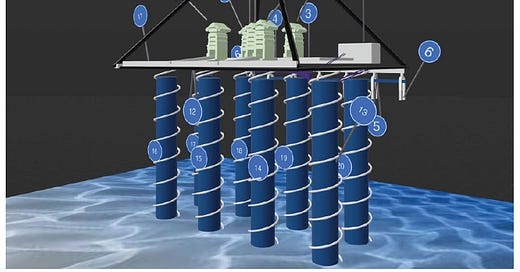Scanning Beneath Giza’s Sands: New SAR Details Deepen the Mystery
Fresh SAR data reveals a two-kilometer subterranean grid beneath Giza’s pyramids, with resonators and piezoelectric granite hinting at ancient energy systems—or Cayce’s Hall of Records?
March 27, 2025
Our journey into Giza’s hidden depths continues with fresh data that sharpens the contours of the 2025 Synthetic Aperture Radar (SAR) findings beneath the Khafre Pyramid. Building on our original thesis—that these discoveries might echo Edgar Cayce’s Hall of Records, unveiled amid a 2015–2025 "Great Awakening"—and our recent explorations of ancient lore and psychic insights, this update delivers new structural and technological details from the Khafre Project team. Sourced from symposium abstracts, press releases, and video transcripts shared by Brian Roemmele (@BrianRoemmele on X), these findings deepen the implications for Giza’s subterranean secrets, potentially bridging science and prophecy.
New Structural Insights from the Khafre Project
The Khafre Project’s symposium abstract, published on ReadMultiplex.com, details the team’s non-invasive SAR analysis of the Khafre Pyramid, building on prior work on Khufu by Filippo Biondi and Corrado Malanga. Above Belzoni’s chamber—long thought to be the Pharaoh’s tomb—five "Zed structures" were identified, each with five horizontal levels and a sloping roof, mirroring a similar structure above Khufu’s King’s Chamber. These Zeds, connected by geometric pathways, are accompanied by secondary structures visible in tomographic images from Capella Space and Umbra satellites. The team’s 3D model, constructed from dozens of images, confirms this internal complexity.
Below ground zero, the SAR revealed eight cylindrical wells, hollow with descending spiral pathways, arranged in two parallel north-south rows, plunging 648 meters to merge into two 80-meter cubic chambers. These structures extend beneath all three Giza pyramids—Khafre, Khufu, and Menkaure—spanning two kilometers, forming a grid-like network of non-natural constructions with complex geometries. A south-north tomographic view shows bright spots (artificial structures) two kilometers below the plateau, with darker pyramid edges indicating low vibrational content. The team plans further analysis and potential excavation to verify these findings, though resistance from Egyptian authorities may delay progress.
Technological Precision and Functional Hypotheses
An article on ReadMultiplex.com, "Below the Giza Pyramid Plateau: New Radar Discoveries Will Shock the World," provides additional context. The SAR, using Biondi’s Doppler tomography, converts radar signals into acoustic data, detecting vibrations from Cairo’s urban activity (traffic, construction) and natural seismic tremors. The 648-meter depth was calculated via radar reflection time delays, with signal-to-noise improvements enhancing visibility of the Zeds’ internal structure. The five Zeds are proposed as "resonators," potentially amplifying vibrational energy, while the cubic chambers may serve as convergence points for energy or symbolic purposes. The granite’s piezoelectric potential—generating electrical charges under pressure, as noted by Dr. Corrado Malanga in a symposium video shared by Brian Roemmele—further supports an energy hypothesis.
Implications for Our Thesis
These details reinforce our core hypothesis: the SAR findings could be Cayce’s Hall of Records, a vibrational nexus near the Sphinx holding Atlantean wisdom, unveiled amid global changes. The two-kilometer grid beneath all three pyramids suggests a unified, pre-dynastic complex, potentially encompassing the Sphinx and aligning with Cayce’s prophecy (Reading 5748-6). The Zeds as resonators and the piezoelectric granite echo Cayce’s "vibratory influences" (Reading 5750-1), supporting our "pyramid as power plant" idea (Dunn’s Giza Power Plant). The spiral pathways and cubic convergence points hint at intentional design, possibly for energy or knowledge storage, resonating with Amenti’s "universal knowledge" and remote viewers’ energetic claims.
Our secondary hypothesis—a "Great Awakening" tied to 2015–2025 upheavals—gains traction. The unified network and energy focus align with Hancock’s pre-cataclysm civilization and Sitchin’s Anunnaki bases, suggesting a lost technology or wisdom humanity is now ready to rediscover. The planned excavation, if realized, could bridge our verification gap, though cultural barriers pose challenges.
A Note on Sources
We owe gratitude to Brian Roemmele (@BrianRoemmele) for sharing translations, summaries, and videos of the Khafre Project’s work, including the symposium video where Dr. Malanga notes the granite’s 680-meter depth and vibrational role. His posts on X have been instrumental in bringing these findings to light. Additional context comes from a 2017 Nature article on the ScanPyramids project, which used muon tomography to detect a 30-meter void in Khufu, inspiring the Khafre Project’s non-invasive approach.
These updates ground our exploration in science while deepening Giza’s mystery. The vibrations beneath the plateau hum louder—stay tuned as we watch for what’s next.
Sources
Khafre Project Symposium Abstract: https://readmultiplex.com
"Below the Giza Pyramid Plateau: New Radar Discoveries Will Shock the World" (ReadMultiplex.com, March 21, 2025): https://readmultiplex.com/2025/03/21/below-the-giza-pyramid-plateau-new-radar-discoveries-will-shock-the-world/
Video Transcript of Dr. Corrado Malanga at Khafre Project Symposium (Shared by Brian Roemmele on X): https://x.com/BrianRoemmele/status/1903127136241848509
Symposium pdf: https://readmultiplex.com/MagazinePDFs/ReadMultiplex-comGizaFindings.pdf
Full original Symposium recording:
Conference recording:
ScanPyramids Project (Nature, 2017): https://www.nature.com/articles/nature24647



